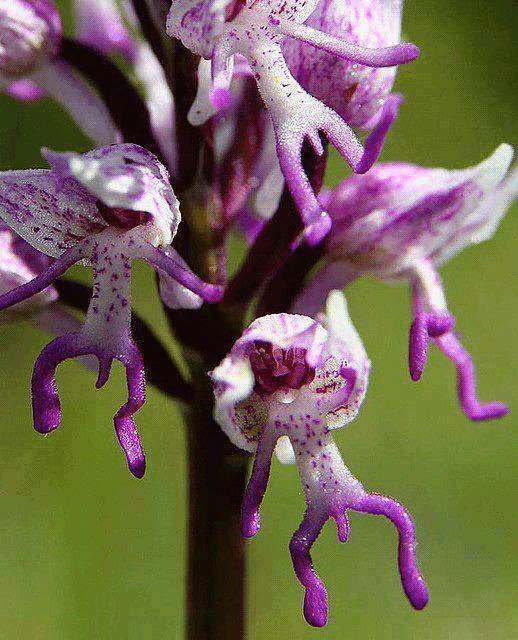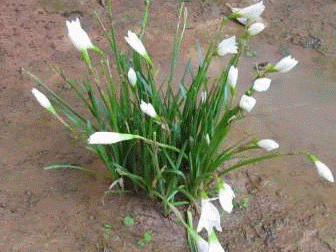Colors
and Words
They
say French is a colorful language, as is Spanish. If one uses their words
wisely, all languages have beautiful ebbs and flows to them. There is a curve,
a sparkle, to the English language as well. Especially when words are used
properly.
I was
perusing an arts and crafts catalog and came upon the glazes section. There
were layers of descriptions, of ways to describe the colors. The first layer
was the simplest of words: blue, gray, and red, pink, purple. Even though we
have different ideas on exactly what kind of blue we want, the color swatches
were indeed blue and red and gray. Sometimes simplicity works.
Then
there's the second level. Words that are associated with things rather than
what it is. Caramel, raspberry, grape, carrot, cinnamon. Who doesn't know what
colors those represent?
The
third level was a little more imaginative. Sour Apple, Orkid, Tuscan Red, Pink-a-boo,
Wine About It, Cara Bein Blue. You get the gist from title of what the color is.
A colorful play on words, to be sure.
Then
come the descriptions that stretch your imagination. Snapdragon. Hawaiian Sand.
Granada
How do
you know when to expand your vocabulary, and when to keep it simple?
One
trick is to read your sentence(s) out loud. Some words are made to be read in
the quiet recesses of your mind. Others are made to read aloud, savoring the
alliteration or the rhyming or the pure creativity of the sentence. J.R.R. Tolkien's
The Fellowship of the Ring or George Martin's A Feast of Crows are stellar
reflections of creative language, but reading them out loud may not sound as
smooth as silk. Especially with a flat, Midwestern accent.
Know
your audience. Too many flowery words may make them roll their eyes and pick up
a magazine. Not enough description will do the same thing.
Another
trick I learned was from the same arts and crafts catalog. Combining two words,
one to evoke an impression, the second the color, is a clever way to leave an
impression on the mind. Smokey Merlot, River Rock, Burnt Jade, Weathered
Copper, Rustic Mustard, Roasted Eggplant -- the combinations are endless. Look
at the scene you're writing, and pull something from the atmosphere and add it
to your color.
Read
other novels, short stories, and poetry. You will be surprised what phrases and
words will call you. When they do, write them down. I have a notebook full of
descriptions and words that I thought were lovely, colorful, dramatic, and
descriptive. I might never use them, but I could get the feel of them.
Use
the thesaurus. Sparingly. There is nothing wrong with finding other words for
your more mundane ones, but readers can tell if you just picked one off the
page or if you thought about it. Make sure the "new" word you use
flows along with the rest of them.
And
don't be afraid to make up your own words. I know that's against most writing
rules, but if you have a character that fits the description, use it. If it all
flows like flowing stream, no one will care. For example, I have a quirky,
pretzelly, smart heroine who is an astrologer. A combination of an astronomer
and astrologer. Looks weird, but once you get to know her it fits her like a
glove.
Colors
are everywhere. Learn to describe them, or better yet, let them describe
themselves. Let the flow of language run through you and into your writing.
Orca
Pod Wiki
Orkid
is a 28 year old female orca who lives at SeaWorld San Diego San Diego September 23, 1988 and was the first orca successfully born at the
park. She was apparently born about a month early. Orkid was named after her
father Orky, who died just days after her birth. Her only living relative is a
half sister named Kayla, who lives in Florida
In 1989,
Orkid's mother was involved in an incident with Corky 2 that turned fatal. Kandu
attacked Corky, crashing into the tank wall. She soon died after hemorraging. Orkid
was 11 months old at the the time her mother died. Corky soon became her surrogate
mother. The two remain together to this day and are still very close as if they
were biological mother and calf.
Orkid
is a dominant orca though she loves making new friends and gets along well with
most orcas. She is close to Kasatka and her family as Kasatka was also a
surrogate mother figure for her. She can be seen with any member of the pod. She
has also developed close relationships with Keet, Shouka and Ikaika. She gets
along well with Ulises, though they did used to have issues in the past. Orkid
has mated with several males, though she has never gotten pregnant. SeaWorld
has mentioned that they do not know why she has trouble getting pregnant since
she seems to show no difference between other females.
Orkid
has been involved in several incidents with humans. After she dragged a trainer
underwater in 2006, she was not allowed to do waterworks. Although she has
shown aggression to trainers, she seems to have very strong bonds with them and
loves attention.
Orkid
is often seen performing in the parks shows. She knows many behaviors and picks
up on new ones very quickly. She also helps in training new behaviors with
other orcas by showing them how to do what they are learning. She can often be
seen incorporating multiple behaviors into one and does some of the more
complex behaviors. The most recent behavior she has learned is called the
Einstein, which is similar to a combination of a back flip and a vertical spin.
The name comes from the fact that it is a very complex behavior and most orcas
probably would not be able to learn or grasp the concept of it. She earned
herself the nickname "Rocket Scientist" due to how smart she is. Orkid
is a very energetic whale as well and is very athletic.
SeaWorld
San DiegoSeaWorld San Diego
Pages
in category "Orkid"
This
category contains only the following page.
Some
killer whales appear predisposed to aggression. Tilikum, now at SeaWorld
Orlando, has been implicated in the deaths of three people, two of them his
trainers. Keto, a SeaWorld orca residing at Loro Parque in Spain, also killed
his trainer in 2010. Splash, who died in 2005, suffered from ill-health for
years and displayed aggressive tendencies. Kasatka, Kayla and many more whales
have been involved in serious altercations.
But no
incident has been more serious than the ones involving Orkid. Internal SeaWorld
profiles of each captive animal were leaked online (you can view them at
OrcaHome.de) and Orkid's behavioral patterns prove particularly disconcerting --
the park noting that the 25-year-old female whale has been involved in multiple
aggressive incidents with trainers. When it comes to interaction with new
trainers, the alleged SeaWorld documents advise, Orkid will “discriminate or
test [them] out.” Orkid has not progressed to killing a person – but she has
been involved in 17 of 87 publicly recorded attacks on humans by SeaWorld
whales, accounting for almost 20 percent of total attacks. What is making Orkid
so aggressive? Is it her traumatic past, or because she is the offspring of two
overly aggressive parents. Does this make her genetically predisposed or a
product of the environment in which she lives? Perhaps it is a combination of
all of these, along with personality and intelligence? “Given that both nature
and nurture create an individual’s characteristics, the reason Orkid is so
aggressive is likely to be complex,” said Lori Marino, a neuroscientist and
expert in animal behavior and intelligence on the faculty of Emory University. Marino,
founder and executive director of the Kimmela Center for Animal Advocacy, has
spent decades studying self-awareness in cetaceans and evaluating the emotional-processing
areas of their brains.
Her
intelligence may not have a clear relationship toward her aggression, or it
could simply allow her to find ways to outsmart or catch trainers by surprise,
she says. Or: “It may be that Orkid, if especially intelligent, is acutely
aware of her captive situation and its effects on her ability to express her
natural behavioral tendencies.” Understanding the role of genetics in Orkid's
aggression is difficult, but Carol Ray, a former SeaWorld trainer and “Blackfish”
cast member believes that other factors feature heavily. “To me,” Ray told The
Dodo, “it boils down to a combination of intelligence and personality
characteristics, and orcas have both.” Marino agreed. “Personality and
intelligence are not entirely separable and often interact,” she said. “Therefore,
it is undoubtedly the case that certain combinations of both factors have
converged to make Orkid who she is today. Given her parent’s temperaments,” Marino
added, “a strong biological predisposition toward aggression cannot be ruled
out.”
Orkid
has been keeping trainers on their toes for the duration of her 25 years at
SeaWorld. In 2002, Orkid and another whale, Splash attacked a trainer named
Tamarie. The incident, as described by John Hargrove in “Blackfish,” left the
trainer with a compound fracture of the forearm. “The Tamarie incident would
have most likely proven fatal if the chain had not been taken off of Kasatka's
gate,” Hargrove said. “Both Splash and Orkid were refusing all attempts to be ‘called
back.’” Splash and Orkid finally paused when they appeared to worry that
Kasatka, the dominant orca, might enter the tank. That gave Tamarie just enough
time to exit. (Local media reported that neither whale had a history of
aggressive behavior, yet in a previously published Dodo interview, Hargrove
reported that Splash often displayed “full-on aggression.”) In 2006, Orkid
attacked another trainer attempting to perform a sonogram. SeaWorld
spokesperson Darla Davis told Fox News that the 35-year-old female trainer was “knocked
off a ‘low-wall,’” and “taken to the hospital after suffering minor injuries,” from
a “bump.” Hargrove, who says he read about it in a corporate incident report
while still a trainer, described the incident much differently. Orkid was
exhibiting strange behavior he said, which prompted the trainer to order the
SeaWorld veterinarian “to step behind the wall immediately for his own safety.”
Orkid “shot up in front of the trainer,” Hargrove said, and as a diversionary
tactic, the trainer signaled to the whale to perform another maneuver. But
Orkid refused, and came up out of the pool instead. “She drilled her [the
trainer] in the chest with her rostrum, knocking her over the elevated wall,” Hargrove
explained. The trainer, “landed on her face and it knocked her out. She was
taken to the hospital and it became a corporate incident report.” On two other
separate occasions, Hargrove told The Dodo, Orkid has dragged trainers to the
bottom of the pool (these are confirmed in the documents allegedly leaked from
SeaWorld). And once, on a stage slide maneuver, the whale hit another trainer,
causing her to suffer internal bleeding that resulted in a two-day
hospitalization. Orkid's 25-year-old history at SeaWorld is filled with tragedy.
The independent whale data site Ceta-Base.com records Orkid’s birth as 1988 in San Diego
But
not only was Orkid the product of an unnatural mating, her parents suffered
bouts of aggression. Kandu V had been involved in at least five alarming
interactions according OrcaHome.de creator, Stefan Jacobs. Citing reports from
The San Diego Union -Tribune, and Erich Hoyt's, “The
Performing Orca – Why the Show Must Stop,” Jacobs describes how Kandu V has
pinned several trainers to the wall, taken them into her mouth, and in one
instance, dragged a trainer to the bottom of the pool. Orky II was equally
worrisome. He entered captivity at Marineland of the Pacific before moving to
Sea World San Diego
The
attack on Sillick generated trouble for SeaWorld. In the article, “How Orky and
Kasatka Almost Sank SeaWorld,” Jason Hribal of CounterPunch, described the
Sillick incident as one of many that forced SeaWorld to sacrifice its own staff
to survive. “The park president, chief trainer, zoological director, and public
relations chief were all fired,” in the process, Hribal said. Orkid lost both
of her parents at a very young age – Orky II just days after she was born. Kandu
V met with a tragic end on Aug. 21, 1989, after she deliberately rammed another
orca. Videos of the incident showing Kandu bleeding to death after breaking her
jaw. And by her side when she died was the less than one-year-old Orkid. She is
noted swimming around her mother frantically as Kandu slowly dies. In Kandu's
necropsy report, Barbara D. Heffernan, SeaWorld's director of Government
Affairs, described the scene for federal authorities. Bleeding profusely, Heffernan
said, Kandu: "Was directed into a specifically designed medical treatment
pool. As Kandu began to lapse into unconsciousness, the veterinary staff
concluded that her calf (Orkid) would be safer if the two returned to one of
the larger back pools. Kandu died in a back pool shortly afterwards, with her
calf nearby.”
The
psychological impact of such an event cannot be measured scientifically. But
Marino believes, “Orkid represents the classic example of gene-by-environment
interaction. Neither her biology nor her experiences protect her against a poor
outcome,” the scientist said. “Rather, both biology and experience have created
an individual who is highly susceptible to mental illness in general and hyper-aggression
in particular. While not a formal diagnosis,” Marino added, “this is likely to
be what has happened.” In a quarter of a century, what has SeaWorld learned
about Orkid's aggressive behavior? From observation, it appears very little. Several
of Orkid's attacks on trainers were included in the U.S.


















































































0 comments:
Post a Comment